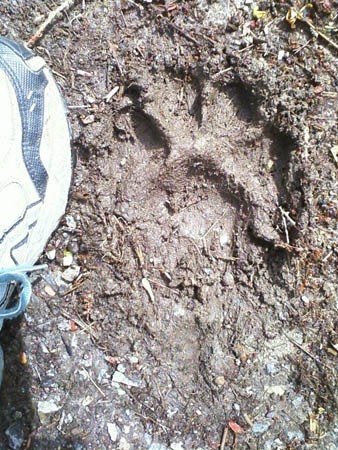On the afternoon of March 30, Islander Barbara VanDyke-Shuman and her husband, Jim, were out for a walk with their grandchildren on a trail on the Mercerdale Hillside south of S.E. 32nd Street. As they walked, VanDyke-Shuman — a self-proclaimed naturalist — looked down at the dirt trail and saw what she knew to be a footprint that did not belong to a neighborhood cat or a dog. She had brought her camera and took photos of the print, using her own shoe for size comparison. The Islander then sent it off to the Washington state Fish and Wildlife office in Mill Creek. A technician, Carol Powers, told her that it was most certainly the footprint of a young bobcat.
The technician forwarded the report to the officer in charge, Sgt. Kim Chandler.
Powers said that bobcats are not uncommon in the suburban areas around Seattle. Two cats have been seen this past week in Mill Creek.
But they are pretty elusive, she explained. They will only stay around if there is enough to eat.
The bobcat that left tracks on the Island hillside is probably long gone by now, she added.
Found throughout all of Washington, bobcats (Lynx rufus) are probably more common than most people realize.
The bobcat is the most abundant wildcat in the United States and has the greatest range of all native North American cats.
According to wildlife experts, there are perhaps as many as one million cats in the United States alone.
Although they are seldom seen, they roam throughout much of North America and adapt well to such diverse habitats as forests, swamps, deserts and even suburban areas. Some are, however, quite bold.
This past week, a 35-pound bobcat wandered into a residence in Port Ludlow. The cat was subdued with a tranquilizer gun and removed by Washington Fish and Wildlife officers.
State Wildlife Officer Win Miller said the homeowner told authorities that the bobcat wandered into the Port Ludlow house through the open front door.
Bobcats are roughly twice as big as the average house cat. Bobcats can be various shades of buff and brown, with dark brown or black stripes and spots on some parts of the body. Their most important feature is a short, black-tipped tail which appears to be cut or “bobbed.” They have white-tipped ears that resemble their feline cousin, the lynx. Adult male bobcats weigh 20 to 30 pounds and average 3 feet in length. Females are considerably smaller and may weigh less than a large house cat. There are ruffs of hair on the side of the head. Bobcats of eastern Washington tend to be a much lighter buff color than those of western Washington. Both colors occur along the eastern side of the Cascade Mountains.
The bobcat track is easily distinguished with a round shape, four toes and no claws evident. It is generally twice the size of a domestic cat’s print and loosely resembles that of a coyote or dog, but is more rounded. Bobcats mark their territory boundaries by leaving claw marks on trees, stumps and occasionally fence posts. Bobcat claw marks are normally 2 to 3 feet above the ground; domestic cat scratching occurs at a height of about 1-1/2 to 2 feet.
There are records of male bobcats mating with female domestic cats; some of the resultant hybrid offspring have shown definite characteristics of the bobcats.
On the state Web site, wildlife officials warn that bobcats are opportunistic and will prey upon a wide variety of animals, including domestic cats and dogs. Pet owners are advised to keep dogs and cats and their food indoors, especially from dusk to dawn. Left outside at night, small dogs and cats may become prey for bobcats.
Wildlife officials advise people not to feed wildlife. Predators follow prey. It is also important to prevent the buildup of feeder foods under bird feeders. Bobcats are attracted to the many birds and rodents that come to feeders.
The Washington Department of Fish and Wildlife offices receive hundreds of reports of bobcat sightings each year. Due to time and funding constraints, officers will only respond when there is a threat to public safety.
For more, go to http://wdfw.wa.gov/reg/region4.htm.


